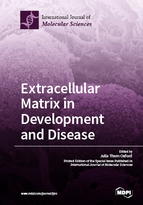Extracellular Matrix in Development and Disease
A special issue of International Journal of Molecular Sciences (ISSN 1422-0067). This special issue belongs to the section "Molecular Pathology, Diagnostics, and Therapeutics".
Deadline for manuscript submissions: closed (25 August 2018) | Viewed by 153078
Special Issue Editor
Interests: rare diseases; zebrafish development; vertebrate skeletal development; protein structure-function; cardiovascular extracellular matrix; cancer progression; extracellular matrix; minor fibrillar collagens
Special Issues, Collections and Topics in MDPI journals
Special Issue Information
Dear Colleagues,
Extracellular matrix in development and disease. This Special Issue will deal with molecular and cellular aspects of the role of extracellular matrix in development and disease. Cells exist in three-dimensional scaffolding called the extracellular matrix. The matrix holds together the millions of cells that make up our blood vessels, organs, skin, and all tissues of the body. The matrix serves as a reservoir of signaling molecules as well. In bacterial cultures, biofilms form as an extracellular matrix and play essential roles in disease and drug resistance. Topics such as matrix structure and function, cell attachment and cell surface proteins mediating cell-matrix interactions; synthesis, regulation, composition, structure, assembly, remodeling, and function of the matrix are included.
A common thread uniting the topics is the essential nature that the matrix plays in normal development and pathophysiology. Providing new knowledge will lead us to improved diagnostics, preventions to disease progression, and therapeutic strategies for repair and regeneration of tissues.
Prof. Dr. Julia Thom Oxford
Guest Editor
Manuscript Submission Information
Manuscripts should be submitted online at www.mdpi.com by registering and logging in to this website. Once you are registered, click here to go to the submission form. Manuscripts can be submitted until the deadline. All submissions that pass pre-check are peer-reviewed. Accepted papers will be published continuously in the journal (as soon as accepted) and will be listed together on the special issue website. Research articles, review articles as well as short communications are invited. For planned papers, a title and short abstract (about 100 words) can be sent to the Editorial Office for announcement on this website.
Submitted manuscripts should not have been published previously, nor be under consideration for publication elsewhere (except conference proceedings papers). All manuscripts are thoroughly refereed through a single-blind peer-review process. A guide for authors and other relevant information for submission of manuscripts is available on the Instructions for Authors page. International Journal of Molecular Sciences is an international peer-reviewed open access semimonthly journal published by MDPI.
Please visit the Instructions for Authors page before submitting a manuscript. There is an Article Processing Charge (APC) for publication in this open access journal. For details about the APC please see here. Submitted papers should be well formatted and use good English. Authors may use MDPI's English editing service prior to publication or during author revisions.
Keywords
- extracellular matrix
- collagen
- biofilm
- embryonic development
- degenerative disease
- fibrosis
- tissue engineering







